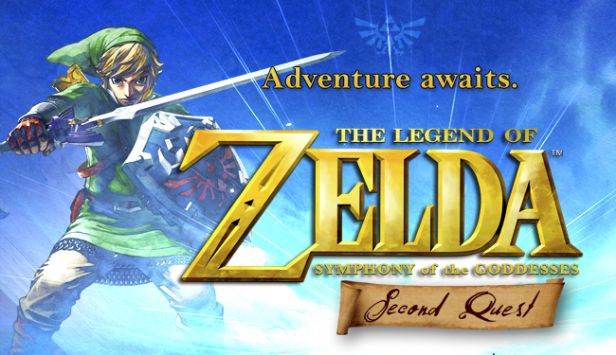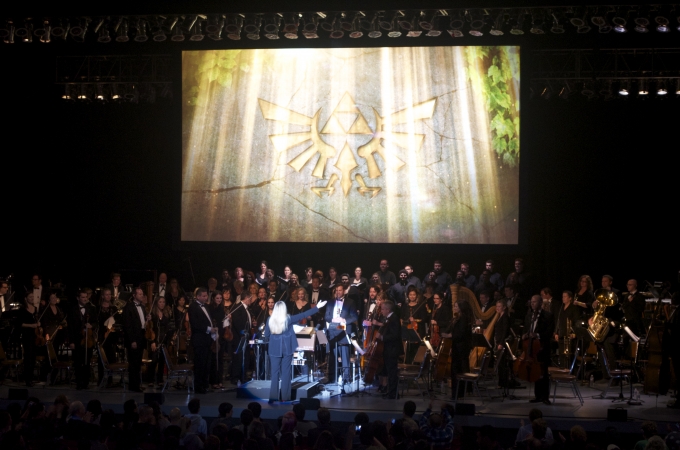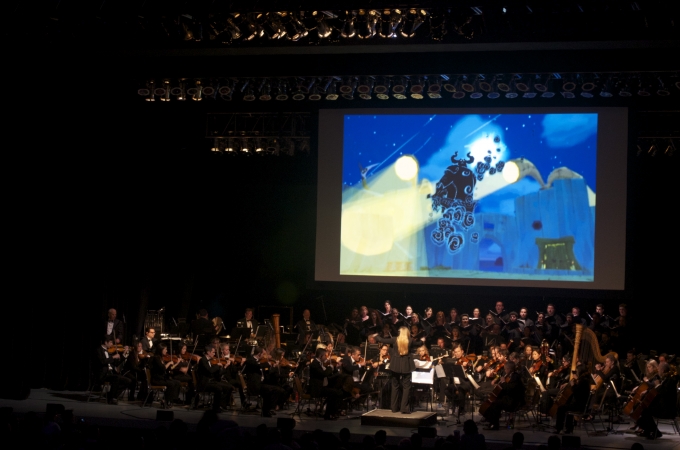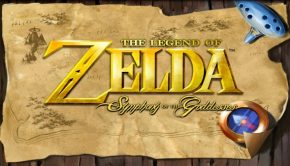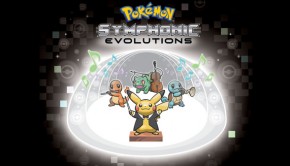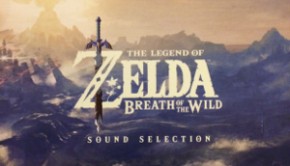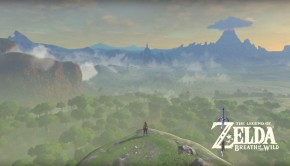The Legend of Zelda -Symphony of the Goddesses- Second Quest: Los Angeles, June 2013
Video game concerts have typically diverged into one of two categories. “Best-of” concerts, such as Video Games Live or Distant Worlds, actively try to present the best pieces of music from a series and evoke memories from those pieces in a loving tribute sort of way. The other category includes game concerts that are actively trying to tell a story in a classical-styled symphony, e.g. Symphonic Fantasies and related concerts. What makes The Legend of Zelda: Symphony of the Goddesses, the critically acclaimed concert from Nintendo and Jason Michael Paul Productions, so interesting is that it succeeds in blending this “best-of” concept with a classical symphonic story. Upon entering its second season — hereby termed “Second Quest” — Symphony of the Goddesses invited us back to the world of Hyrule, with new musical pieces and new sequences of in-game footage. This resulted is a masterful adaptation of The Legend of Zelda story, and one that improves on the original concert, while spearheading new material forward in delightful and surprising ways.
I arrived at the Greek Theater in Los Angeles, filled with excitement and commotion due to the nearby E3 conference. Gamers from around the world were there, donning Zelda shirts, playing and connecting with each other on their 3DSs, and excitedly chatting about The Legend of Zelda. Cosplayers wandered about, in full armor and regalia, awaiting the show with bated breath. Many industry professionals and musicians were also there, and I even managed to meet Tommy Tallarico among other prominent composers prior to the start of the show. The entire audience had a very electrifying and excitable energy, and this was especially reflected from the show’s creators. Conductor Eímear Noone smiled as I asked her about tonight’s revamped program, saying, “Well, I’m not going to give you any spoilers, I’m afraid. But, what I do want to say is, the reason that there is a Second Quest is because of the generosity and passion of Zelda fans the world over.” Indeed, this “global family” of Zelda fans have passionately connected with this concert series, and have come to love this symphonic treatment of one of their most beloved game franchises. With that in mind, we sat down as Symphony of the Goddesses began.
The concert began with the familiar “Overture,” comprising the series’ “Main Theme,” “Ganon’s Theme,” “Zelda’s Theme,” Twilight Princess‘ “Hyrule Field,” and Skyward Sword‘ “Ballad of the Goddess.” The Overture had undergone little change since its original performance during Nintendo’s 2011 E3 press conference. I will admit that back then, the piece seemed a little too melodramatic for my tastes, despite being exceptionally composed. However, after hearing the Hollywood Studio Symphony perform the piece flawlessly, I can honestly say it is a moving tribute to Koji Kondo’s classic Zelda score, and it is a fantastic opener from Symphony of the Goddesses’ arranger Chad Seiter.
Following the “Overture,” Eímear Noone introduced us to the concert, stating excitedly that they were celebrating their 50th show. She then brought out arranger/orchestrator Chad Seiter and producer Jeron Moore, the masterminds behind the show. Jeron reminisced on his original Zelda experience, bringing out the classic gold NES cartridge, while Chad stated that he originally had his start with the series on the Gameboy. As he produced the small gray Link’s Awakening cartridge, he happily announced, in honor of the game’s 20th anniversary, they had made a new Link’s Awakening medley. Jeron also announced that they would be staying in the handheld territory for a while, with the second inclusion of the night, a medley based on the more recent Spirit Tracks. And with that, we entered Second Quest’s new material.
The “Link’s Awakening Medley” started off with a perfect orchestral translation of the game’s “Opening Scene,” with some hints at “Ballad of the Windfish” and the series’ “Main Theme.” It was an amazing opening to the medley, and one that fully enveloped the audience into the Zelda world. “Finding the Sword,” a sweet little motif from the game’s tutorial, followed, intertwining hints of “Ballad of the Windfish” through use of the choir. “Mabe Village” continued this sweet, nostalgic tribute to Link’s Awakening, exploring some of the fun silliness of the game. However, this didn’t last very long, as the orchestra entered into “Tal-Tal Heights,” a very powerful, almost Spanish sounding, arrangement of the series’ main theme. Not only did the theme sound amazing, but it fully captured that feeling of adventure that Zelda games so embody. It’s also quite impressive to hear Game Boy music sound so good via the orchestra and choir, and it was a true testament to Kazumi Totaka, Minako Hamano, and Kozue Ishikawa’s original compositions. Following a sad yet mysterious sounding interlude, the orchestra launched into a dramatic, melancholy, and somewhat dissonant version of “Ballad of the Windfish.” Although past concerts had featured a beautiful sounding rendition of the theme as an encore, here it was played more in time with the story, and thus provided an excellent introspection of the (rather dark) ending to Link’s Awakening. The medley ended with one last melancholy, yet very beautiful echo back to this theme.
We continued with the “Spirit Tracks Medley”, opening with “The Spirit Flute,” which forms the basis of the game’s opening motif, and a very critical part of the game’s climax. Here, it was played with the piano and violin as a basis in a sweeping, uplifting, and yet slightly sorrowful way. “Chancellor Cole’s Theme,” a villainous, and yet slightly bumbling theme, followed next, quickly fading out to “Steam Train Field 1,” the first of two overworld themes that serves as training music during Link’s first excursion in the game. It’s a very fun, adventurous theme, featuring two very short but absolutely gorgeous solos from the violin and flute. The music once again translated perfectly onto the orchestra. After briefly expressing forthcoming mystery, the orchestra played “The Tower of Spirits,” a musically simple march that Mr. Seiter has expanded upon, adding to the story’s weight, as we transition into the final boss, featuring three brilliantly arranged pieces set back-to-back to each other. “Duet with Zelda,” a reprisal of “The Spirit Flute,” is a gorgeous and melodious song, that heightens the heroism as we went straight into “Malladus Battle,” a climactic piece once again using the opening motif. With tensions flaring, out of nowhere a dramatically arranged version of “Steam Train 2” (considered to be the main theme of the game, and featured prominently in the 25th Anniversary Symphony concerts and subsequent CD release) revealed one of the most emotional and heartfelt moments of the concert thus far. One last trumpet announced the final statement of this theme, bringing an end to an excellently arranged medley from Mr. Seiter.
With these two, 7-8 minute long, tracks we witnessed the majority of the changes to Symphony of the Goddesses. Gone are “The Dungeons of Hyrule” medley, “Karariko Village – Twilight Princess Theme,” and “Songs of the Hero – Ocarina Melodies” medley. While these removed tracks were all excellent and very moving pieces to hear live, they focused on individual concepts of the Zelda series, such as the dungeons and melodies Link explores and hears throughout his journey. Here, instead, the team has instead focused on continuing to tell the Zelda story, and giving a brilliant take on both these games. While it may seem odd to add these large medleys to the track listing, especially considering that the bulk of the concert is still the four-movement symphony proper, I would argue that this is the essential next step in Symphony of the Goddesses. Jeron Moore and Chad Seiter have essentially continued to adapt each game to the orchestra, and audience members can relate to these stories more, especially seeing each character in action in each subsequent game. It is a solid merging of the “best-of” and “symphonic story” concept.
Moving on, we continued with the “Symphony” portion of the show, virtually unchanged from its original debut. I already talked in full detail about the symphony, so I’ll cover it briefly here. Unfortunately, due to lack of rehearsal time, the “Prelude – Creation of Hyrule” piece had to be cut from that night’s show. Instead, we were sprung headfirst into “Movement I – Ocarina of Time,” an emotional retelling of the most famous Zelda game to date. This movement definitely moved from emotional highs to emotional lows, especially when presenting the astoundingly beautiful, yet melancholic “Title Theme.” It quickly moved to the adventurous “Hyrule Field” and finally dropped to the fun yet somewhat lonely “Saria’s Theme.” After a brilliant take on “Shiek’s Theme,” which cleverly hides “Zelda’s Theme” underneath its melody, “Ganondorf Battle” roared unflinchingly, ending on one of my personal favorite moments in the concert, the powerful, dramatic, and all in all excellently arranged, “Ganon Battle,” ending “Ocarina of Time” in a dark, but satisfying way.
Next, the concert featured the ever-fun “Movement II – The Wind Waker,” now bringing back even fuller memories as The Legend of Zelda: The Wind Waker HD prepared to launch on the Wii U. Eímear Noone has also introduced a new element to the show, by pausing here and speaking of her childhood in Ireland, as she always dreamed of becoming a conductor. To her surprise and delight, The Legend of Zelda: The Wind Waker actually celebrated the act of conducting by placing the conductor’s baton as the game’s central mechanic. The audience clapped joyfully as Ms. Noone pulled out the familiar Zelda item and began to play “Movement II – The Wind Waker,” with a real-life replica of the Wind Waker baton. Going into the music briefly, it’s much more lighthearted than Ocarina of Time, and musically seems to now resemble the “Spirit Tracks Medley.” Highlights included the triumphant “Great Sea Theme,” the dramatic “Ganondorf Battle,” and the incredibly moving “Wind Waker Main Theme/Staff Credits,” which funny enough resembles a classic Irish Jig. With the second movement’s stratifying conclusion, we ended the first half of the show and were given a brief intermission.
One of the all-time, most popular pieces of Zelda music is “Gerudo Valley” from Ocarina of Time. It was thus given the orchestral treatment during the 25th Anniversary Symphony concert, was placed on the special CD released with Skyward Sword, and was even brought back for Symphony of the Goddesses as an encore piece. It has returned once more for Second Quest, this time acting as the intermezzo piece between Movements II and III. While it still remains a fan favorite, and it is a very great arrangement from Mr. Seiter, I feel as if it is somewhat overplayed at this point, especially given the fact that it doesn’t convey the same style as the original’s flamenco-infused rhythm. I also dearly missed “The Great Fairy’s Fountain,” the original intermezzo piece that played during the first iteration of Symphony of the Goddesses, which seemed to fit the overall theme of the concert better, and made for a better transition between Movements II and III. However, this is a minor nitpick, as we would soon be thrust into the darkest and most emotional Movement of the symphony.
“Movement III – Twilight Princess,” is a very brooding, yet heroic piece of music, and it is still a definite highlight to Symphony of the Goddesses. Beginning with the memorable “Title Screen” and flowing straight into “Lamentation of the Spirits,” Twilight Princess distinguished itself with some of the most well developed music of the series. “Midna’s Theme,” a tender but darkened theme that became a submotif for the entire movement, shows off one of the most beloved characters of the entire series. However, the main attraction of “Movement III” was arguably “Hyrule Field,” one of the most epic themes in the entire Zelda universe. Transitioning into the ominous “The Sage’s Theme,” it quickly moved into the awesome final boss theme, “Dark Lord Ganondorf.” THe movement transitioned into one of the greatest endings I’ve ever heard in a video game. “Staff Credits 2,” one of the most emotional and powerful pieces and an incredible concert highlight, before wrapping up with the choir singing “Midna’s Theme” one last time.
The final movement began with that audience bursting into cheers at the sight of A Link to the Past’s original 16-bit graphics. Musically, “Movement IV – A Link to the Past” continued exploring the darkness of the Zelda series. “Rain Scene,” “Hyrule Castle,” “Zelda’s Lullaby,” and, “The Sanctuary” remained as powerful as ever. However, the music took a turn for sheer brassy heroics with “The Dark World,” a continuing fan-favorite theme. After the intense final battle, “Ganon Battle,” complete with pounding, rhythmic percussion, the movement ended with a moving rendition “End Credits,” echoing “The Triforce Chamber Theme” in perhaps my favorite moment in the symphony. It is a simply powerful theme that allowed the audience to reflect upon the overall adventure they have experienced. Finally, the medley ended where it started, with an incredible rendition of “The Legend of Zelda Main Theme.” With one final callback to “The Triforce Chamber Theme,” the symphony came to a close with standing ovations from the audience.
Of course, we weren’t quite done yet. Jeron Moore and Chad Seiter quickly returned on stage to announce that the first encore of the evening was one that they simply could not remove from the initial setlist, and has returned as an encore for Second Quest. Dedicated to arguably the darkest and most surreal Zelda tale, “Majora’s Mask Suite” returned once again. Last time, I neglected to talk in depth about the piece, especially since it was the last encore of the night,and was heavily anticipated by fans, but I’ll give an overview here. The piece began with the solemn but mysterious “Opening Scene,” quickly transitioning into the nefarious “Majora’s Mask Theme,” which is musically similar to “Ganon’s Theme,” but much darker and more demented. As Link fell into the world of Termina, the strings let out a rising and slightly creepy tremolo note, as the quirky and fun “Clock Town” theme began to play. It is a very important and nostalgic piece for fans, and Chad Seiter absolutely nailed it with his arrangement, which goes above and beyond as “Clock Town – The Third Day” begins to play. In one of the most impressive moments of the concert, the melody of “Clock Town” began to be distorted by the “Majora’s Mask” theme as the whole scene erupted into chaos and madness, transitioning perfectly into the climactic “Majora’s Wrath Battle,” the final boss theme of the game. A solemn, almost march, version of “Last End” began to play, as the moon descended on Termina. Suddenly the choir cries out the final theme of the piece, the dark, lyrical, and mournful “Oath to Order.” A single soprano voice wailed one last time as the piece came to an end. “Majora’s Mask Suite” is an incredible piece and a masterful arrangement from Mr. Seiter. It also fits better in Second Quest’s setlist. In the original Symphony of the Goddesses, it was the last encore piece, and although amazing, it unfortunately ended the concert on a sad, dark note, which I always found odd, considering The Legend of Zelda’s overall optimistic and adventurous themes.
However, there is still more new material in Second Quest, with two new encores, both of which I won’t spoil. They both bring new ideas to the table, and bring an overall cohesiveness to the rest of Symphony of the Goddesses’ story. The final encore especially draws from a very important theme to the Zelda story, and one that fans have waited for since Symphony of the Goddesses was first announced. It is an astoundingly beautiful theme, and perhaps the perfect way to close out the concert, moving many to tears. Second Quest is an astonishing success, and one that again paves the way for the continuing Zelda storyline. Jeron Moore, Chad Seiter, Eímear Noone, Jason Michael Paul, and the rest of the team have done it again. The Legend of Zelda: Symphony of the Goddesses – Second Quest is a near perfect blend of the best of Zelda music and an incredibly developed symphonic story – and a must see for Zelda and game music fans all over the world.
Posted on June 12, 2013 by Julius Acero. Last modified on July 12, 2014.

